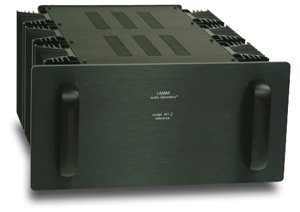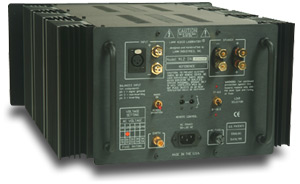![[SoundStage!]](../titles/sslogo3.gif) Home
Audio Home
Audio Equipment Review |
|||||
Audio designers, like audio reviewers, all start somewhere. Vladimir Lamm's start came with the creation of the hybrid topology used first in amplifiers made briefly under the Madison-Fielding brand name and then for the company that bears his name, Lamm Industries. The hybrid, fully class-A M1.1 monoblock was manufactured unchanged for a decade, a notable accomplishment in the audio world, where products are usually updated or revised within a few years of introduction. I reviewed the M1.1 way back in 1997, and to say I was impressed with it would be a king-sized understatement. I used a pair of M1.1s as my reference amps for quite some time, and they were eventually supplanted in my system by other Lamm amplifiers, first the all-tube, push-pull ML1 and then the SET ML2. I am, therefore, approaching a decade of using Lamm amplifiers (and preamplifiers) exclusively, and I've done so simply because they mimic the sound of live music to a degree that most other products do not. There are more powerful amps on the market, and those that address certain aspects of reproduced sound in a more showy (and sometimes subjectively better) way, but Lamm electronics never fail to touch those of us who appreciate a human portrayal of music, as opposed to one that's strictly reproduction, a hi-fi portrayal. After ten years of uninterrupted manufacture, the M1.1 became the M1.2 and the first Lamm amplifier to carry the Reference appellation. While the heart of the M1.2 Reference's circuit -- its use of solid-state output devices and a single 6922 tube -- remains identical to that of the M1.1, a number of parts have been changed, making for not only a rather different amp but also one that is more powerful. The M1.2 Reference's nominal output power is 110 watts, up 10% from the M1.1's output. (Due to its load selector, which changes the supply voltage and idle current of the output stage, the M1.2 Reference is able to deliver its full class-A output power into any speaker load.) Lamm has "redesigned the high- and low-voltage power supplies for the front end; some critical parts have been replaced with higher-quality ones which have appeared on the market recently; certain changes have also been made to the output stage." Also, the power transformer now has a 230V tap, so the M1.2 Reference (and new M2.2) operates at 100, 120, 220, 230 and 240 volts, 50-60Hz. A final change is in the price: the M1.2 Reference costs $19,590 per pair, up over $1000 per amp from the M1.1's final price.
Jeff Fritz at our sister publication Ultra Audio was the first to write about the M1.2 Reference, in his case as part of "The World's Best Audio System." I agree with Jeff on the overall quality of the M1.2 Reference's sound, which he described as "tonally neutral yet richly textured sound that does nothing but serve the music." However, Jeff found that he needed to get used to the M1.2 Reference's sound, that initially he was merely "politely impressed." I, on the other hand, have to adjust to the sound of most other amps, especially those that are purely solid state, so quickly and easily did I fall under the spell of the M1.1 and now the M1.2 Reference. One of the most interesting sound-related experiments you can do is a simple one: sit in your listening room and talk with someone whose voice you know well (if that person can sing, even better). When we listen to each other, we almost exclusively concentrate on the words, not on the voice of the person speaking, its attack, decay, pitch, timbre and other defining qualities. If you listen to a voice you know well in your listening room -- actively listen, as you do to your audio system -- you won't hear sound that's like that from your speakers. It's more subdued, devoid of the unique emphasis that much audio equipment imparts to the sound of reproduced music. Attack and decay are not showy but are present, and the timbre, the identifying marks of this voice you know well, are obvious, but not highlighted. The voice is what it is. This experiment demonstrates that live sound is less dramatic and sensational than reproduced sound, especially as we audiophiles often define it, but it is the real thing, and there's no denying it. Some audiophiles have argued that live and reproduced music are two different things, and while this is technically true, reproduced music needs to display the elements of live music to sound believable. "Believable" describes the sound of the M1.2 Reference amps, especially by the criteria of the "voice in the room" experiment. Music from the M1.2 Reference simply sounds real. "Organic" and "natural" are often used to describe the sound of Lamm electronics (I've used them more than a few times), and what they attempt to convey is the sense of reality, and lack of audiophile showiness, that Vladimir Lamm's designs convey. While you get different mixes and intensities of this general characteristic with each Lamm amp and preamp, the family resemblance is always there -- and always something to which certain audiophiles will respond with no small enthusiasm. I count myself among these. But even with all of their naturalness, the Lamm M1.2 Reference amps can convey fireworks. Their bass, for instance, has impressive depth and density, along with a touch of warmth that gives the region greater fullness and bloom than that of most purely solid-state amps. Is it realistic? It sounds that way to me, although I concede that the Simaudio W-6's more taut bass was very musically consonant as well. Still, the plucked string of an electric bass is plush, opulent. This is how the M1.2 Reference portrays it, and still satisfies with the sock and slam of the kickdrum. In the mids, no solid-state amp I've heard can touch the M1.2 Reference, whose portrayal of voice is much of the reason why Lamm electronics are called "natural" and "organic" in the first place. There is a sense of fidelity and beauty, a golden transparency, to the way the M1.2 Reference amps portray the midrange, and while the tubed Lamm monoblocks raise this a notch, no one who is used to the often threadbare, even bleached, mids of many competing amplifiers will think the M1.2 Reference amps anything less than superlative. One recent discovery, Maggi, Pierce and E.J.'s latest CD, unofficially titled The Gold Album [EMPrecords CD5G] because of the color of its cover, sounds glorious over the M1.2 References. The music reminds me of the eclectic folk dabbled in by the Holy Modal Rounders, spiced with the playfulness of The Presidents of the United States of America and the sweet voice of Maggi (she doesn't like to reveal her last name), who sounds a lot like Frete!'s Angie Hart. According to PR materials, the trio lives together as "common-law siblings," which may account for the calculated looseness of their music. Whatever the elements may be, the M1.2 Reference amps convey them with the sort of honesty and grandeur that very few amps can equal. I can keep going, talking about the delicate treble that's completely devoid of grit and grain, even at very high volumes; the copious fine detail; the dynamic prowess that the Lamm ML1.1 and ML2.1 can't equal. However, doing so will only restate the fact that these amps do everything to an exceedingly high level and thereby promote long-term satisfaction -- a life filled with musical bliss. It's been far too long a time since I heard the M1.1 for me to make any meaningful comparisons between it and M1.2 Reference, but based on company history, the M1.2 Reference should be in the Lamm product line for many years. Hence, you will have plenty of opportunity to hear the M1.2 References and judge for yourself. If you're lucky you'll hear them driving Wilson Audio speakers, for which they seem built. If being an audiophile is about the music for you (sadly, there are plenty of audiophiles for whom it is not), the Lamm M1.2 Reference amps are a smart choice. They're certainly a Reviewers' Choice and one of the very best amplifiers you can buy. ...Marc Mickelson
|
|||||
|
|||||
![[SoundStage!]](../titles/sslogo3.gif) All
Contents All
ContentsCopyright © 2004 SoundStage! All Rights Reserved |


 The M1.2 Reference looks
identical to the Spartan M1.1, and in my opinion, it is one of the most attractive
amplifiers available. It almost screams "I'm a power amplifier!" instead of
attempting to look like a network server or some other 21st-century appliance that it is
not. I suspect some audiophiles will not take as kindly to its squat, dark good looks as I
do, but nobody will bad-mouth the inclusion of handles on the front and back. The M1.2
Reference is a cumbersome 75 pounds, and those handles make lugging it around a little
easier.
The M1.2 Reference looks
identical to the Spartan M1.1, and in my opinion, it is one of the most attractive
amplifiers available. It almost screams "I'm a power amplifier!" instead of
attempting to look like a network server or some other 21st-century appliance that it is
not. I suspect some audiophiles will not take as kindly to its squat, dark good looks as I
do, but nobody will bad-mouth the inclusion of handles on the front and back. The M1.2
Reference is a cumbersome 75 pounds, and those handles make lugging it around a little
easier.